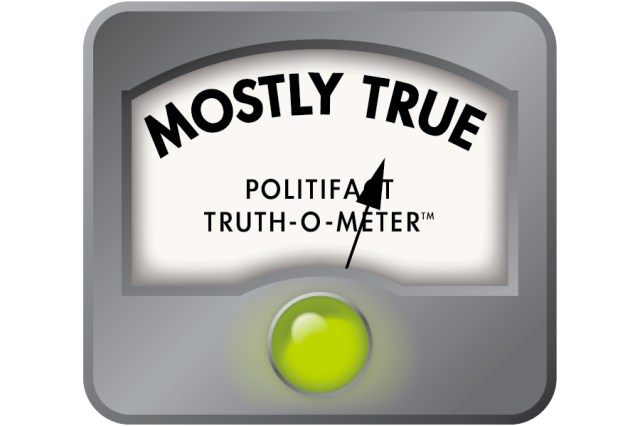“Americans will get $1.1 B in rebates from health insurance companies this year cuz of a provision I wrote in the ACA.”
Former Sen. Al Franken (D-Minn.), in a tweet on May 17, 2023
Former Democratic Sen. Al Franken tweeted recently that Americans will receive “$1.1 B in rebates from health insurance companies this year” because of a provision he wrote into the Affordable Care Act.
The tweet prompted many comments, including some from people who said they had never seen such a check from their insurers. That got us wondering: Is Franken’s tweet correct and, if so, how exactly do these rebates work?
We reached out to Franken’s press team to ask about the source of his data but received no reply.
Nonetheless, we found lots of information on the topic. As with everything else related to health insurance, it’s complicated.
Bottom line, though: There are rebates, probably along the lines of $1.1 billion for this year. But the chance that any given consumer will see one is fairly small.
First, the Background
Franken was a senator from Minnesota during the drafting of the Affordable Care Act, which was signed into law in 2010 by then-President Barack Obama. That measure, also known as Obamacare, included a provision related to rebates. And, yes, Franken did get it inserted in the law, said health insurance expert Louise Norris.
It’s known as the medical loss ratio, or MLR, and though it sounds wonky, it’s pretty straightforward. The MLR refers to how much insurers spend on medical care for their enrollees versus other administrative costs. The ACA provision aims to curb the amount of premium dollars that insurers use for administrative costs, which can include marketing, profits, and executive salaries and bonuses.
“We now have the numbers where we can see how much they spent, how much they took in, and how much must be rebated,” said Norris, a health policy analyst for healthinsurance.org. “It holds these companies accountable.”
How Does It Work?
The MLR is calculated not based on what any individual patient spends on premiums or other medical care costs during the year. Instead, the standard insurers must meet is to spend at least 80% of their premium dollars, in some instances more, on “the collective you: all the people in the plan,” said Cynthia Cox, a KFF vice president, who directs KFF’s Program on the ACA.
So insurers add up all the premium dollars they bring in across a state for each type of plan they offer, such as those sold to individuals, those that cover small businesses, and those that cover large employers.
Then they add up all the claims costs for medical care for all the customers enrolled in those plans. For policies offered to individuals or small groups, the insurer must have paid out at least 80% of premiums on direct medical care or quality improvements. Large employer plans must spend 85% on medical care. An added nuance: The totals are aggregated over the previous three years.
Consumers “individually might have spent a lot of money on premiums last year and used no health care,” Cox said. But that’s not what the MLR is attempting to gauge. It examines whether plans “offer a good value for all those people who are enrolled.”
If those targets are not met, rebates kick in.
There are many reasons insurers might miss the target.
One is that, because they set premiums well in advance of the actual plan year, insurers can guess wrong, either over- or underestimating demand or costs for care. For example, insurers set their 2020 premiums during summer 2019, when no one knew the covid-19 pandemic would strike months later. Then, instead of increasing medical costs, the pandemic actually led many enrollees to avoid seeing the doctor or going to the hospital. So that year’s premiums were wildly out of line with spending. The largest volume of rebates in the ACA’s history, $2.5 billion, was given out in the 2020 plan year, according to a KFF report.
This year, an estimated $1.1 billion will be paid, about in line with the previous year’s rebates, the same report said.
Still, the estimate is preliminary, and not all insurers have weighed in with their data. Notices about rebates are expected later this year.
Most enrollees won’t get a rebate check because most insurance plans fall within the limits set by the law, Norris said.
The ACA’s first rebate checks were issued in 2012, when about $1.1 billion was distributed. That annual total dropped for a few years as insurers got better at estimating costs and setting premiums, but it has varied, with big spikes during the pandemic.
Overall, nearly $11 billion has been rebated since 2012, Norris said.
There Are Caveats
Anyone who gets health coverage through their job is unlikely to see a direct rebate. Notably, self-insured employers, which pay their medical costs directly and include the vast majority of large employers, are not subject to the MLR.
If you work for an employer that buys coverage from an insurer and is owed a rebate, you still might not get a cash payment. Instead, employers can use the rebate to boost benefits or offset employees’ share of the cost of health coverage. Either way, the rebates are divided between the workers and the employer. The employer tends to pay the larger portion of the premium costs, in which case it receives the larger check.
In the individual ACA market, consumers owed money could either get a check or get the rebate in the form of a premium credit, according to KFF.
Last year, about 6.2 million consumers nationally, 2.4 million in individual plans and the rest in a group or employer plan, qualified for a rebate check, according to Norris’ analysis of government data. While that’s a sizable number of people, it’s still a small percentage of the more than 170 million who have job-based or ACA coverage.
The average amount nationally was $167, with the largest being in South Dakota, whose rebate recipients received an average of $603, she wrote. Rebates weren’t warranted in five states: Alaska, North Dakota, Oregon, Rhode Island, and Vermont.
So, was Franken accurate when he tweeted that Americans would receive this billion-dollar windfall? And will these rebates really reach everyone, or just a select few?
Norris said many insurers approached those spending limits even before the ACA but that the law better defines the parameters, reins in spending on nonmedical costs, and allows for rebates. Overall, that can benefit “anyone in a commercial health plan, regardless of whether they are getting a check or not,” she said.
She pointed to the pandemic and how it dampened demand for medical care well after insurers set their premiums. “If we didn’t have the MLR rules, there would have been nothing to prevent carriers from keeping those excess profits,” Norris said.
Still, the estimated $1.1 billion in rebates expected this year doesn’t necessarily mean those required to issue them are “outrageously profitable right now, because it’s a three-year average, which still includes early pandemic years, when insurers were profitable but only because people were using less health care than anyone would have guessed,” Cox said.
Our Ruling
Franken was largely correct in characterizing the insurance rebate provision and his role in getting it into law. There will be rebates sent out this year, but the $1.1 billion is still technically an estimate of the amount and could change based on final insurer data.
But his tweet was off the mark in implying that Americans broadly would see direct rebates. While the number of Americans who get a rebate this year may be similar to last year’s 6 million, that’s a single-digit percentage of the total number of people with insurance. Still, Americans are likely to benefit in some form this year — such as through richer benefit packages or reduced cost sharing. But very few will get an actual check in the mail.
We rate this Mostly True.
sources
Phone interview with Cynthia Cox, a KFF vice president and director of KFF’s Program on the ACA, May 22, 2023
Phone interview with Louise Norris, a health policy analyst for healthinsurance.org, May 23, 2023
AlFranken.com, accessed May 22, 2023
MinnPost, “Franken’s Health Care Reform Rebate Provision Kicks In on Wednesday,” July 31, 2012
KFF, “2023 Medical Loss Ratio Rebates,” May 17, 2023
Centers for Medicare & Medicaid Services, “Medical Loss Ratio,” accessed May 22, 2023
Healthinsurance.org, “Billions in ACA Rebates Show 80/20 Rule’s Impact,” May 23, 2023
KFF Health News is a national newsroom that produces in-depth journalism about health issues and is one of the core operating programs at KFF—an independent source of health policy research, polling, and journalism. Learn more about KFF.
USE OUR CONTENT
This story can be republished for free (details).











